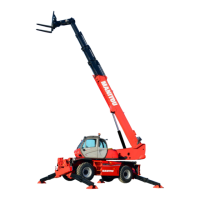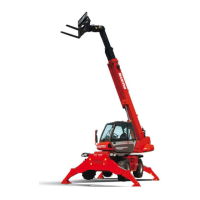648970 IT-EN-NO (18/06/2018)
MRT-X 2150 Privilege Plus ST3A S2 / MRT 2150 Privilege Plus ST4 S2 / MRT-X 2550 Privilege Plus ST3A S2 / MRT 2550 Privilege Plus ST4 S2
1-28
IT EN NO
Gjør aldri følgende når indikatoren for
lastestatus er i alarmforhold:
A - Strekke ut armen.
B - Senke armen.
- Hvis indikatoren for lastestatus er i
alarmforhold, må følgende bevegelser
- som letter på belastningen - utføres i
oppgitt rekkefølge (fig. P):
1 - Trekk armen helt inn.
2 - Hev eventuelt armen.
3 - Senk armen slik at lasten settes ned.
Truck med korrigeringsanordning for
helling.
-
Korriger hellingen med
hydraulikkontrollen, og kontroller den
vannrette posisjonen på vateret før
armen heves (se kapittel STYRE- OG
KONTROLLINSTRUMENTER i del 2 -
BESKRIVELSE).
I tillegg til underlagets tverrgående helling,
kan andre parametere påvirke truckens
vannrette posisjon.
• Dekkenes tilstand og trykk.
• Underlagets stabilitet.
• Lastens balanse.
• Sterk vind eller storm.
Før hver håndtering, kontroller de
ovennevnte forholdene og at trucken er
helt vannrett.
(Kontroller på vateret.)
If the load status indicator alarm is
actived, do not carry out the movements
said to be “WORSENING”, which are the
following :
A - Extend the jib.
B - Lower the jib.
- If the load status indicator alarm is
actived, carry out in all security move
ments in the following order (Fig. P) :
1 - Fully retract the jib.
2 - If it’s necessary lift the jib
3 - Lower the jib in order to lay the load.
Lift truck with level corrector
-
Correct the slope using the hydraulic
control and check the horizontal position
on the level before lifting the boom(See
chapter : INSTRUMENTS AND CONTROLS
in paragraph : 2 - DESCRIPTION).
Apart from the transverse slope of the
ground, several parameters can upset the
horizontal position of the lift truck.
• The tyre pressures.
• The stability of the ground.
• The balance of the load.
• Strong wind or stormy conditions.
Before any handling work, check the
points above and ensure that the lift truck
is completely horizontal.
(See bubble level)
Quando l’indicatore di stato di carico è in
allarme, non bisogna in alcun caso:
A - Far uscire il braccio.
B - Abbassare il braccio.
-
Se l’indicatore di stato di carico è in
allarme, effettuare i movimenti sgravanti,
nel seguente ordine (Fig. P) :
1 - Rientrare il braccio al massimo.
2 -Se necesario alzare il braccio
3 - Abbassare il braccio in modo da
posare il carico.
Carrello elevatore con correttore
d’inclinazione.
-
Correggere l’inclinazione, agendo
sul comando idraulico e verificare
l’orizzontalità sulla livella prima
di sollevar il bracio(Vedi capitolo
: STRUMENTI DI CONTROLLO E
DI COMANDO, nella parte : 2 -
DESCRIZIONE).
Oltre alla pendenza trasversale del
terreno, altri parametri possono incidere
sull’orizzontalità del carrello elevatore.
• Lo stato e la pressione dei pneumatici.
• La stabilità del terreno.
• L’equilibrio del carico.
• Il vento forte o la tempesta.
Prima di ogni movimentazione, controllare
le condizioni sopraelencate e verificare
che il carrello elevatore sia perfettamente
orizzontale.
(Controllare sulla livella a bolla)
P
